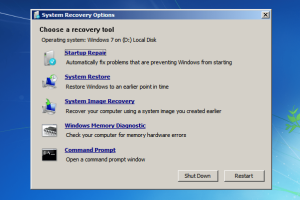Comprehensive guide to system recovery options in Windows. The system recovery options crucial feature in Windows 7 is a vital element when encountering severe errors preventing the system from starting correctly. On your computer, these helpful tools can be conveniently accessed from the disc installation of Windows. This article will delve into the assortment
Comprehensive guide to system recovery options in Windows.
The system recovery options crucial feature in Windows 7 is a vital element when encountering severe errors preventing the system from starting correctly. On your computer, these helpful tools can be conveniently accessed from the disc installation of Windows. This article will delve into the assortment of recovery tools at your command and educate on how to gain access to them.
Understanding the Different Recovery Tools
Startup Repair: The Startup Repair tool rescues Windows when certain issues, like missing or damaged system files, hinder its smooth startup. Smooth startup process is guaranteed by identifying and resolving common issues.
System Restore: System Restore enables you to rewind time on your device by resetting its operating system without impacting your user files like documents, photos, and emails. While system recovery is possible from the options menu, please be aware that once performed, it cannot be reversed. You can opt to restore your system again with System Restore, selecting an alternative point of restoration. This may or may not work, depending on various factors.]
System Image Recovery: To utilize this option, you must have a system image created beforehand. A customized system image is similar to a tailored backup that contains your Windows layout, applications, and user information, including documents, pictures, and music. Your computer can be restored quickly with a system image in case of a malfunction, crash, or virus outbreak. The table provides an exact recovery of your system akin to the image it was upon creation.
Windows Memory Diagnostic Tool: If you suspect your computer’s memory is causing performance issues, try running the Windows Memory Diagnostic Tool. Assessing your device’s memory for error and offering solutions.
Command Prompt: Command prompt power-users can apply their skills to perform recovery-related tasks and use handy tools to diagnose and fix problems masterfully.

Image by https://www.google.com/
Accessing System Recovery Options
The steps to access the System Recovery Options menu on your computer are available now that you are aware of the tools at hand.
Using F8 Key during Startup:
Press and hold the F8 key if your computer has a single operating system installed to initiate a system restart. Do this before the Windows logo appears to avoid any glitches or issues. If the Windows logo pops up, try waiting for the Windows logon screen to appear, and then shut down and restart your PC. Highlight the operating system you want to repair using the arrow keys, and then press and hold the F8 key to enter the system menu. When accessing the Advanced Boot Options screen, select
Using Installation Disc or USB Flash Drive:
If your computer is terribly messed up and cannot open the System Recovery Options menu, you can try accessing it using a Windows 7 installation disc or a USB flash drive. To complete this, reboot your computer utilizing the disc or USB flash drive. Follow the installation disc instructions to install Windows 7 or shut down the computer with the USB flash drive or repair disc. Discs are inserted during startup, before your PC was activated. This can also cause compatibility issues with newer PCs and games. After the computer restarts, please follow the screen prompts.’]
Using a System Repair Disc:
Thanks to the creation of a system repair disc, accessing the System Recovery Options menu is now possible. Reinsert the system repair disc and reboot for better computer performance. Kindly enter a specific character or word to proceed with the recovery process.
See what tips and advice we have for System Recovery Options.
Regularly back up important files to protect against data loss in case of computer crashes.
To ensure you have access to System Recovery Options, create a repair disc beforehand. This will enable you to fix any issues, including severely damaged systems, without losing important data. Make sure you create the disc before any potential issues arise.]
Learn the consequences of System Restore, which cannot be reversed once initiated. It’s a helpful tool that can restore previous computer performance and software application states.
Have your Windows installation files or USB flash drive nearby for unexpected occurrences.
Recovery options may be tailored to specific brands of devices.
Customization by Computer Manufacturers
Certain computer manufacturers may tailor their System Recovery Options menu by including their own tools or omitting specific recovery options. Your computer’s available tools may vary depending on its brand.
Conclusion,
Windows 7’s System Recovery Options provide critical system restoration tools. Acquiring proficiency in these recovery and access tools is beneficial for when your computer encounters serious technical problems. It is crucial to devise an efficient system repair disc and frequently back up important files to ensure a smooth recovery process. Moreover, implementing a comprehensive recovery system can also shield against potential file loss.

















Leave a Comment
Your email address will not be published. Required fields are marked with *